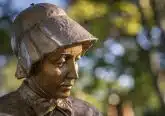Relics of St. Elizabeth Ann Seton to be displayed this summer at her shrine
by Christine Rousselle
Washington D.C., Mar 4, 2021 / 02:00 pm MT (CNA).- The Sisters of Charity of New York have donated several of St. Elizabeth Ann Seton’s relics to the National Shrine of St. Elizabeth Ann Seton, it was announced on March 1.
The relics, which include the saint’s religious bonnet, rosary, and crucifix, will be displayed in an expanded museum at the shrine, which is located in Emmitsburg, Maryland. Seton was the first American-born person to be canonized.
The donation “was a surprise,” Rob Judge, the executive director of the Seton Shrine, said to CNA.
“We knew that they had these wonderful artifacts and they’ve loaned us artifacts at different times,” he said of the Sisters of Charity, “but it was really their generosity–they’re recognizing that this is a momentous year for the shrine.” Seton died in 1821, and Jan. 4 marked the bicentennial of her death.
The bicentennial “has been an opportunity to share her story on a deeper level, with more people in the Church and in the world,” said Judge.
The Sisters of Charity of New York, who Judge called “great partners” with the shrine, donated the relics with the intent of helping to share the saint’s story. While they originally displayed the artifacts at their archives and museum in Riverdale, New York, the sisters determined they “needed a climate-controlled environment” and could be seen and venerated by more visitors at the national shrine in Emmitsburg, the shrine said in its release.
“They just decided to [donate the relics] out of their own generosity and desire to share Mother Seton,” Judge told CNA. “And we’re just humbled and grateful.”
The relics include Seton’s bonnet, rosary, her family broach she wore on her wedding day, and the christening gown worn by her daughter.
Judge called these items “just really precious artifacts that help make her relatable and help us tell her story.”
Seton, who was canonized in 1975, was born in New York City in 1774. She was raised Episcopalian and was received into the Catholic Church in 1805, two years after the death of her husband, William. She and William had five children together including Catherine, the first American to join the Sisters of Charity.
Following her conversion to Catholicism, Seton eventually moved to Emmitsburg, Maryland and founded a Catholic school for girls and a religious community to care for the poor.
Judge thinks that Seton’s life story resonates with Catholics today, noting the saint had “such a broad life experience” that included times of joy and times of extreme sorrow.
“She had such a strong belief in God’s providential care, that he had a plan that she would see us through, and that led her through her life,” said Judge. Seton’s husband and two of her children died of tuberculosis, something that Judge thinks is particularly relevant during the ongoing coronavirus pandemic.
“She knew what it was like to live through a pandemic,” he said.
Seton is “an incredible model as a young woman, as a wife, as a religious, and as someone who was just a believer and a seeker,” said Judge.
Her relics will be on display at the National Shrine of St. Elizabeth Ann Seton this summer. The shrine remains open to visitors with COVID-19 prevention protocols.













